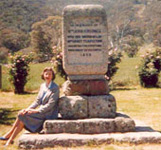
Divisions
- Home
- Tasmanian Government Policy and Programs
- Women's organisations to join
- Information and resources
- Tasmanian Honour Roll of Women
Contact Details
By phone
Find the number of a specific division or office to contact them directly or call Service Tasmania on 1300 135 513.
Our staff
Use the Tasmanian Government Directory to find staff contact details
Eliza Forlong


Awarded for service to Agriculture
Born: 1784
Died: 1859
Entered on roll: 2005
Perhaps the most important importation of all sheep was that made by Eliza Forlong and her sons, having personally selected flock of the very finest pure merino sheep. Forlong blood has meant much to the super-fine flocks of Australia, and there are very few clips of superfine quality which do not have a liberal infusion of it, either directly or indirectly. (R Taylor Winton)
Born in Glasgow, Elizabeth Jack married John Forlong in 1804. They lost their first four children to tuberculosis. When William, one of their two surviving sons, developed symptoms of tuberculosis in 1826, Elizabeth and John resolved to emigrate to a warmer climate in the hope of improving his health. The family decided to establish themselves in New South Wales as producers of Saxon merino wool. Eliza undertook the task of selecting the finest merino sheep in Saxony. She travelled by foot, buying sheep for William’s voyage on the Clansman in 1829 and for her own voyage on the Czar in 1830. In all, Eliza and her sons walked across Saxony three times, leading flocks of 100 sheep to the port at Hamburg.
In June 1829, 16-year-old William sailed for New South Wales with a flock of seven rams and 90 ewes. The Clansman stopped at Hobart en route, where Governor Arthur recognised the value of the flock and persuaded William to take up a large grant of land near Campbell Town. On reaching Van Diemens Land in January 1831, Eliza, John and Andrew, and a second flock, joined William at the Kenilworth property. These sheep formed the basis of the Winton superfine stud at Campbell Town, Australia’s pre-eminent superfine wool stud, and the neighbouring St Johnstone stud.
In 1839, frustrated by their lack of a river frontage and unhappy about their failure to secure additional land grants at Kenilworth, the widowed Eliza and her sons moved to the Port Phillip District, taking a flock of 1200 sheep. In 1844, the Forlong family sold Kenilworth and 4000 prize merinos to the Taylor family, the owners of the Winton stud.
Eliza continued to take an active role in the family’s pastoral interests until her death in 1859 at William’s property, Seven Creeks Station, near Euroa. Her grave is marked by the Forlonge Memorial, on the creek flats of the property. In 1940, Lady Clark, wife of the Governor, unveiled a sundial to perpetuate the memory of Eliza at the Kenilworth Estate.
Image: Forlong Memorial, Euora
 Tasmanian Honour Roll of Women
Tasmanian Honour Roll of Women